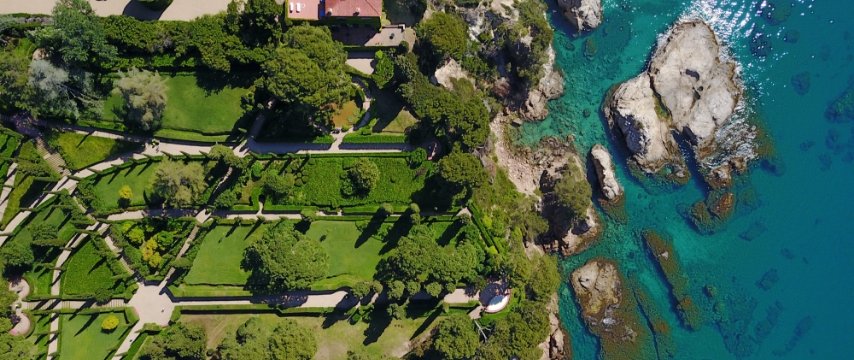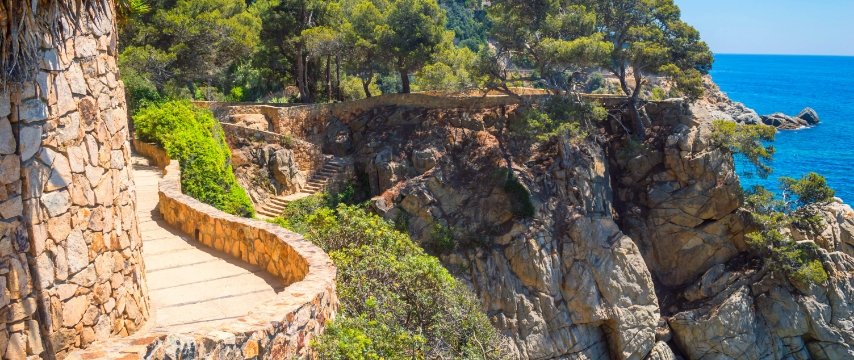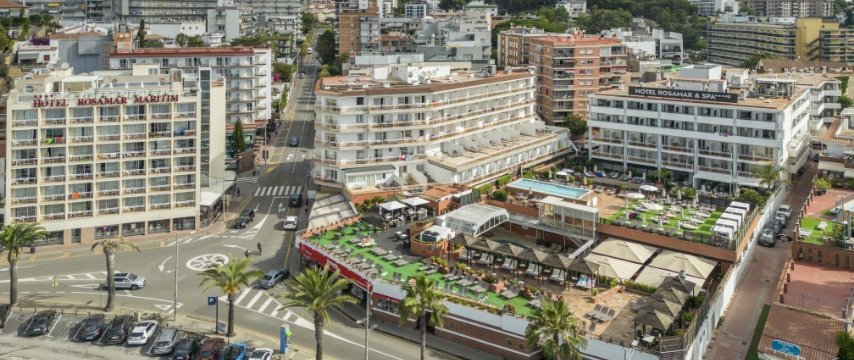

Lloret de Mar is a city with a lot of history and many places hidden away that you can't miss if you have the chance to visit the Costa Brava. Whether you're looking for tranquility or adventure, Lloret de Mar has everything you need to enjoy an unforgettable experience by the Mediterranean. Discover the best things to see and do in Lloret de Mar!
The Castle of Santa María, better known as Castell d’en Plaja, located in the small and quiet cove of Sa Caleta (located between Cala Canyelles and Lloret beach), is one of the most emblematic buildings in Lloret de Mar.
This majestic neo-Gothic style castle was the work of the Girona architect Isidor Bosch i Bataller. The construction began in 1933 and was completed after the Spanish Civil War. It stands out for its circular towers, ogival windows and the small viewpoint with views of the sea that is accessed through a private path.
Currently, it is owned by the Girona businessman Narcís Plaja Martí, married to María Vilà i Ruyra, niece of the Catalan writer Joaquim Ruyra. You can get to Castell d’en Plaja by the promenade of the beach or from the coastal path (Camí de Ronda).
One of the essential places to visit in the center of Lloret de Mar is the Church of San Romà, located in plaça de l'Església.
This building was built between 1509 and 1522 and rebuilt in 1914 thanks to financing from the Indians, which is why today it reflects two periods of construction and architecture as different as the Gothic style and the Modernist style.
This church stands out for its temple covered with mosaics using the trencadís technique used by Antoni Gaudí, which consisted of uniting ceramic fragments of uniform sizes with mortar.
Santa Clotilde Gardens are, without a doubt, one of the most charming corners of Lloret de Mar. Located on a cliff between Fenals beach and Sa Boadella, with spectacular views of the Mediterranean Sea, these Renaissance-inspired gardens with sculptures and ponds were designed in 1919 by the architect Nicolau Rubió i Tudurí.
The price of admission to Santa Clotilde Gardens is quite affordable and its opening and closing times can be consulted on the website of Lloret de Mar’s tourist office.

One of the most romantic places in Lloret de Mar is Dona Marinera viewpoint (Mirador de la Dona Marinera), one of the places with the best panoramic views of the Costa Brava, located between the large beach of Lloret de Mar and Cala Banys.
It contains a 2.40-metre-high bronze sculpture, work of the Catalan sculptor Ernest Maragall, which represents a female figure looking at and waving at the sea, symbolizing the women who awaited the arrival of the sailors. A tribute to the fishing past of the town.
Legend has it that those who touch the foot of the statue looking at the horizon will see their wishes come true.
One of the main reasons to visit Lloret de Mar is its beaches and coves. In addition, it is one of the Catalan municipalities with the most "Blue Flags" distinctions for its compliance with environmental conditions and facilities.
In this coastal town located on the Costa Brava we can find the beach of Lloret de Mar, in the center of the municipality, just in front of the Plaza de la Vila; the Fenals beach, the second largest beach in Lloret de Mar, and Santa Cristina beach, a small semi-urban beach located south of the town.
In addition to the beaches, Lloret de Mar has coves such as Sa Caleta, located north of Lloret beach, just opposite the Castell d'en Plaja; Sa Boadella, cove with a specific area for nudists; Cala Banys, a rocky cove with one of the most charming bar-restaurants in Lloret de Mar, and Cala Treumal, at the southern end of Santa Cristina beach.
One of the best proposals to get to know the surroundings of Lloret de Mar and at the same time exercise is to walk the Camí de Ronda coastal path, a path that borders the coastline of the Mediterranean coast passing near cliffs and coves. In Lloret de Mar there are two routes that lead to the neighboring coastal towns.
The section from Lloret de Mar to Tossa de Mar, approximately 11 kilometres, passing through the Castillo d'en Plaja, the Iberian settlement of Turó Rodó, some coves such as Cala dels Frares and Cala d'en Trons or the Club Náutico in Cala Canyelles until reaching the foot of the walls of Tossa de Mar.
The section from Lloret de Mar to Blanes, about 8.5 kilometres, passes through the main beaches of the Lloretense town, such as Cala Banys, Playa de Fenals, Cala Sa Boadella, Santa Cristina beach and Cala Treumal, before reaching to Cala Sant Francesc and Sa Forcanera, ending at the rock of Sa Palomera.
Check out these sections of the GR 92 in Lloret de Mar!

If you feel like taking a walk in front of the sea, promenade Mossèn Jacint Verdaguer is the perfect place. It is a red sand promenade 300 meters long by 50 meters wide surrounded by palm trees located in front of Lloret de Mar Beach.
It was promoted by the Indians who built their houses near the sea and inspired by the colonial environment of the Americas. At one end of the promenade, we can find the Casa de la Vila and at the other the Casa Garriga, two other buildings from the Indian era.
Also known as “Cal Conde” or “Can Piuet”, Can Font is one of the modernist style buildings in Lloret de Mar that you absolutely have to visit. It has a basement, ground floor, first and second floor, attic and patio, joined by a staircase located in the center of the building, and still preserves the original decoration of the ceilings, walls and furniture of the time.
The building was built in 1887 commissioned by the Indian Nicolau Font i Maig. The city council of Lloret de Mar acquired the building in 1981 and it is the only Indian-style public house-museum that is currently preserved in Catalonia.
Although it may seem surprising to include a cemetery among the ten essential places in the town, the modernist cemetery of Lloret de Mar, declared an Asset of Cultural Interest, is one of the main examples of funeral art from the 19th century in Catalonia, being inspired by a small town for the deceased, with avenues, streets and cemeteries.
The reform of the cemetery was promoted at the end of the 19th century by the Indians, when the location of the cemetery was changed and the project was entrusted to the architect Joaquim Artau i Fàbregas, in which prestigious architects such as Josep Puig i Cadafalch and Bonaventura Conill Montobbio, disciple of Antoni Gaudí, also participated.
The last place to visit on this list is the Castle of Sant Joan in Lloret de Mar, which is located on top of a hill between Lloret de Mar Beach and Fenals Beach. It dates from the 11th century AD, when the population of Lloret de Mar originated, and its function was to protect the region from attacks by sea.
The castle resisted during the battles throughout the years until the British bombardments of 1805, which had disastrous effects on the tower, which meant the definitive destruction of the fortified enclosure.
To get spectacular views of the Lloret de Mar coast and enjoy the contrasts of the blue sea and its mountainous surroundings, you can climb the castle tower. Although admission to the site is not free, the price is quite affordable.
If you want to discover all the corners that the town of Lloret de Mar hides, at Rosamar Hotels you will find five hotels located a few meters from Lloret de Mar beach, relatively close to the center of the municipality and the main tourist attractions.
Hotel Rosamar Maritim, Hotel Rosamar Garden Resort and Hotel Rosamar & Spa are perfect for trips with family or children, while Hotel Rosamar Es Blau Adults Only +21 and Hotel Rosamar Maxim Adults Only +21, only for adults, are perfect for trips as a couple or with friends.
Book now at Rosamar Hotels and don't miss anything in Lloret de Mar!

At the Dona Marinera viewpoint you will find one of the best panoramic views of the Costa Brava. In addition, you can see the most emblematic monument in Lloret de Mar, La Dona Marinera.
In Lloret de Mar there are two GR 92 routes that lead to neighboring coastal towns, Tossa de Mar, to the north of the municipality, and Blanes, to the south. If you are a hiking lover, you cannot miss these two routes starting in Lloret de Mar and going along the coastline paths.
If you are planning your getaway on the Costa Brava for this summer and want to discover the city of Lloret de Mar, in this post we bring you the perfect guide to get to know the town in just two days. Discover the best things to see and do in Lloret de Mar!
The new HBO Max series, House of the Dragon, has been recorded in the Santa Clotilde Gardens in Lloret de Mar. The prequel to Game of Thrones, based on the novel Fire and Blood by George R. R. Martin, which tells the story of the Targaryen house two hundred years before the events of Game of Thrones.
The Costa Brava is one of the best destinations to enjoy the beach in summer, but the winters in this corner of the Catalan coast are from another world. When its beaches and towns are empty of tourists, the best time of the year arrives to rediscover the Catalan coast. In this post you will find the best things to do on the Costa Brava in winter!
Lloret de Mar’s city council has organized a cycle of gastronomic experiences with showcooking, wine tasting and a daiquiri and tapas workshop led by the best local talent in the field of gastronomy at the Lloret de Mar’s local market to publicize the comprehensive remodelling that will be carried out this 2023. Do not miss it!
Spring is one of the best seasons to visit Lloret de Mar. Despite filling up with tourists during the summer months, this time of year is the perfect time to explore the town in a relaxed way. Pleasant temperatures, empty beaches, streets without crowds... Come and enjoy the tranquillity of Lloret de Mar in spring!
Are you tired of always making the same plans during the holidays? We discover the best cultural, gastronomic and sports proposals to do in Lloret de Mar during the coming months and not get bored for a second this summer!
Do you have 24 hours to visit Lloret de Mar? It is possible to explore one of the best-known towns on the Costa Brava in just one day. We tell you the main places to visit in the town of Girona so that you can make the most of your stay.
Can Font, also known as Cal Conde or Can Piuet, is a modernist-style building in Lloret de Mar built in 1877 by the Lloret-born Fèlix Torras i Mataró, commissioned by Nicolau Font i Maig. Everything you didn't know about the only Indian-style house-museum in Catalonia!
Immerse yourself in the history of Lloret de Mar by exploring the Maritime Museum - Can Garriga, Can Saragossa and the Can Font House Museum. Get ready to discover a maritime and cultural legacy that will captivate you!
Now that spring is approaching, come and discover the magic of Santa Clotilde Gardens in Lloret de Mar in their maximum splendor. An oasis of natural beauty and serenity in the heart of the Costa Brava. Discover them!
Do you want to know how the Iberians lived in Lloret de Mar? You can do it at Can Saragossa, an old farmhouse that houses permanent exhibitions on how the Iberians lived in the municipality. Discover it!
The Castle of Sant Joan is an 11th century fortification that is located on a cliff sixty meters high that separates the beaches of Lloret de Mar and Fenals, making it a magnificent space to enjoy fantastic panoramic views of Lloret de Mar.
The church of Sant Romà is one of the most representative buildings in the town. It is located in the centre of Lloret de Mar, in the Plaça de l'Església. The building is in Gothic style, but its two side chapels are in the Art Nouveau style and use the trencadís technique.
Discover the Castle of Lloret de Mar, a 20th century architectural gem. Perched on cliffs and surrounded by natural beauty, this emblematic castle offers an unparalleled visual experience, soak up its history and marvel at its charm!
In summer the temperatures rise and all you want is go for a swim on the beach. The town of Lloret de Mar, in the Costa Brava, has several urban beaches and hidden coves that makes it a perfect destination to go on a family, couple or friends vacations.